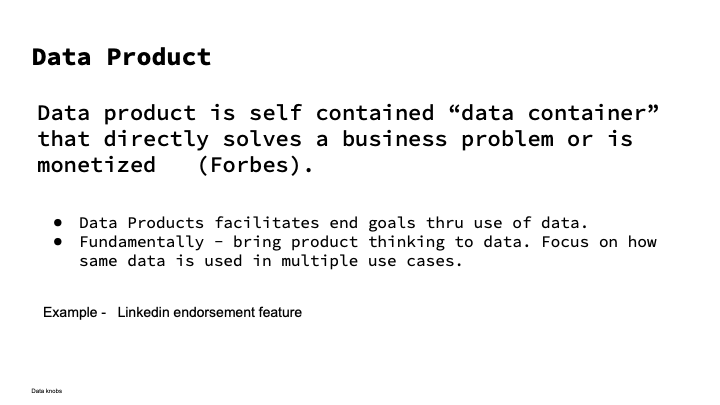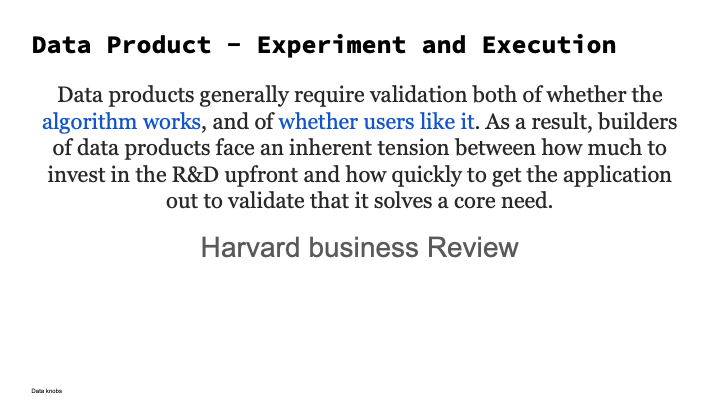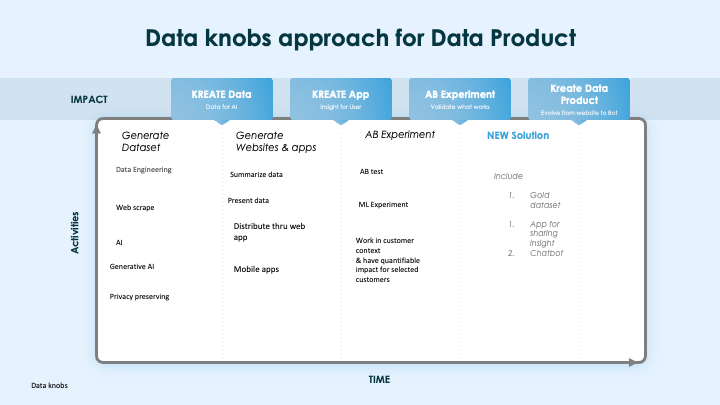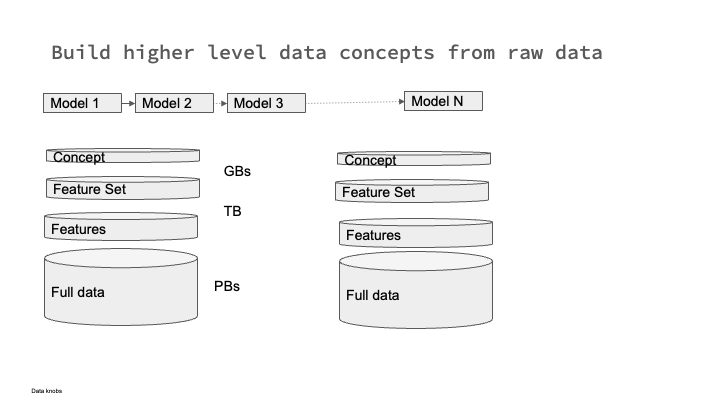Data products 101 and slides

DATA PRODUCT DEFINITION |

3 IMPORTANT THINGS USER,DATA |

HARVARD BUSINESS REVIEW ALGO |

HOW TO DESIGN DATA PRODUCTS |

SOFTWARE PRODUCT VS DATA PRODU |

DATAKNOBS APPROACH FOR BUILDIN |

BUILD HIGHER LEVEL CONCEPTS BY |
Build Data Products Right From The StartAn integrated platform to Kreate, Kontrol, and Experiment with your data products, turning complex challenges into manageable solutions. The Dataknobs ToolkitEverything you need to ship robust data products, faster. Create Signals and DataGenerate and refine the core datasets that power your applications. Create KnowledgeBuild intelligent knowledge bases to drive insights and automation. Create Websites & PortalsDevelop user-facing applications and portals directly on the platform. Create Assistants & AgentsDesign and deploy AI-powered assistants to automate tasks and engage users. Guardrails & PolicyEnforce governance with robust policy controls and safety guardrails. Prompt ManagementCentralize and control the prompts used by your AI models. Data LineageMaintain full visibility into your data's origin and transformations. Enterprise IntegrationSeamlessly connect with third-party controls and enterprise systems. A/B Test WebsitesEasily run A/B tests on your websites and portals to optimize user experience. Automated Data ExperimentsValidate algorithms and data quality with automated experimentation. Prompt-based ExperimentationTest and iterate on AI prompts to find the most effective interactions. Experiment RepositoryTrack and manage all your experiments in a centralized repository. Turn the KnobsOur core philosophy revolves around "Knobs"—powerful levers for tuning, diagnosis, and experimentation. Fine-tune every aspect of your data product with intuitive controls. AI Workflow LeversAdjust model parameters, data sources, and processing pipelines in real-time. Experimentation & DiagnosisIsolate variables, diagnose issues, and control experiment parameters with precision. Business & Domain KnobsEmpower domain experts to tune the product based on business logic and market needs.
|
Data products 101 and overview |
Data as product |
Benefits of Data-as-Product for CIOsAs a data architect, I believe that CIOs can benefit greatly from implementing a data-as-product strategy. By treating data as a product, CIOs can:
Benefits of Data-as-Product for EnterprisesEnterprises can also gain significant benefits from a data-as-product approach, including:
Planning for Building Data-as-ProductWhen planning for building a data-as-product strategy, CIOs should:
|
Data as product service |
Data-Product-as-ServiceAs a data architect, I would like to describe the concept of data-product-as-service to experts. Data-product-as-service is a business model where companies offer data products as a service to their customers. This means that instead of selling data as a one-time product, companies offer access to their data through a subscription-based model. Advantages: The advantages of data-product-as-service are numerous. Firstly, it allows companies to generate recurring revenue streams. Secondly, it provides customers with access to up-to-date and relevant data. Thirdly, it allows companies to maintain control over their data and ensure that it is being used in a responsible and ethical manner. Business Models: There are several business models that companies can use for data-product-as-service. One model is the pay-per-use model, where customers pay for the data they use. Another model is the subscription-based model, where customers pay a monthly or yearly fee for access to the data. A third model is the freemium model, where customers can access a limited amount of data for free, but must pay for additional data. Benefits: Companies can benefit from data-product-as-service in several ways. Firstly, it allows them to monetize their data assets. Secondly, it provides them with a recurring revenue stream. Thirdly, it allows them to maintain control over their data and ensure that it is being used in a responsible and ethical manner. Fourthly, it allows them to provide their customers with up-to-date and relevant data. |
Capabilities/platform requie to build data as products in an enterprise |
Core capabilityOnce you build new dataset, there are additional capabilities require for On top of these you also want feedback on data/ recommendation of data When an eneterprise build data product, it also pay attention to |
Bulding-modern-data-products Co-pilot-aiase Copilot-for-data-products Data-as-product-cio Data-as-product Data-lake Data-mesh-for-data-products Data-product-as-service Data-product-capabilities Data-product-optimization